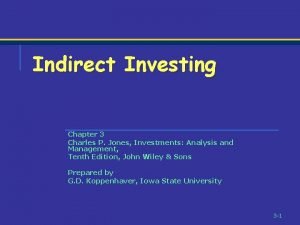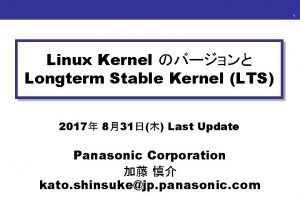Investing Investing Longterm process of placing money in








- Slides: 8

Investing • Investing: Long-term process of placing money in some medium in the expectation of receiving future benefit • Speculating: Future value and expected returns are highly uncertain PFIN 6| CH 11 1

Investment Objectives Once you have sufficient savings— for emergencies and other purposes —you can start building up a pool of investable capital. This often means making sacrifices and doing what you can to live within your budget. Granted, it’s far easier to spend money than to save it, but if you’re really serious about investing, you’ll have to accumulate the necessary capital. PFIN 6 | CH 11 2

Asset Allocation A portfolio is a collection of investments assembled to meet a common investment goal. Asset allocation focuses on the question of how to divide your portfolio among different types of securities. For example, what portion of your portfolio will be devoted to short-term securities, to long-term bonds and bond funds, and to individual common stocks and equity funds? By dividing a portfolio among different classes of securities asset allocation attempts to minimize the effects of negative market developments PFIN 6 | CH 11 3

Ways to Invest Common stocks Bonds- Preferred and convertible securities Mutual funds, exchange traded funds (ETFs), and exchange traded notes (ETNs) Real estate (has the highest liquidity risk) PFIN 6| CH 11 4

Ways to Invest—Common Stocks Common stocks are a form of equity—each share of stock represents a fractional ownership position in a corporation. A share of stock typically entitles the holder to equal participation in the corporation’s earnings and dividends as well as an equal vote to elect the management of the corporation. From the investor’s perspective, the return to stockholders comes from dividends and/or appreciation in share price. Common stock has no maturity date PFIN 6| CH 11 5

Ways to Invest—Bonds In contrast to stocks, bonds are liabilities—they’re IOUs of the issuer. Governments (state, local, federal) and corporations issue bonds that pay a stated return, called interest. An individual who invests in a bond receives a stipulated interest income, typically paid every six months, plus the return of the principal (face) value of the bond at maturity. For example, if you purchased a $1, 000 bond that paid 10 percent interest in semiannual installments, you could expect to receive $50 every six months (10 percent × 0. 5 years × $1, 000) and at maturity recover the $1, 000 face value of the bond. PFIN 6| CH 11 6

Ways to Invest--Mutual funds An organization that invests in and professionally manages a diversified portfolio of securities is called a mutual fund. A mutual fund sells shares to investors, who then become part owners of the fund’s securities portfolio. Most mutual funds issue and repurchase shares at a price that reflects the underlying value of the portfolio at the time the transaction is made. Mutual funds have become popular with individual investors because they offer a wide variety of investment opportunities and a full array of services that many investors find particularly appealing. PFIN 6| CH 11 7

Ways to Invest—Exchange Traded Funds Exchange traded funds (ETFs) are similar to mutual funds in that they, too, represent portfolios of securities. They are usually set up to track a basket or index of securities (e. g. , the S&P 500) or a particular sector such as telecommunications or utility stocks. They also can include other types of investments, including bonds and real estate. Although mutual funds can only be bought or sold at the end of the day, investors can trade ETFs throughout the trading day, just like individual shares of stock. Further, ETFs provide more favorable tax treatment than mutual funds. PFIN 6| CH 11 8















